General Depth First Search
The knight’s tour is a special case of a depth first search where the goal is to create the deepest depth first tree, without any branches. The more general depth first search is actually easier. Its goal is to search as deeply as possible, connecting as many nodes in the graph as possible and branching where necessary.
It is even possible that a depth first search will create more than one
tree. When the depth first search algorithm creates a group of trees we
call this a depth first forest. As with the breadth first search our
depth first search makes use of predecessor links to construct the tree.
In addition, the depth first search will make use of two additional
instance variables in the Vertex class. The new instance variables are
the discovery and finish times. The discovery time tracks the number of
steps in the algorithm before a vertex is first encountered. The finish
time is the number of steps in the algorithm before a vertex is colored
black. As we will see after looking at the algorithm, the discovery and
finish times of the nodes provide some interesting properties we can use
in later algorithms.
The code for our depth first search is shown below. We use a set to
maintain a record of the nodes that have been visited as we recursively
traverse through our sample graph. For each vertex, any neighboring
vertices that have not yet been visited are traversed. This is much like
our depth first traversal for our knight’s tour solution, except that
we do not need to keep track of the path taken to reach every vertex,
allowing us to more simply use our visited set.
We also introduce a traversal_times dictionary here in which the keys
are vertices and the values we populate as dictionaries of the form
{'discovery': m, 'finish': n}, where the m and n values are
integers obtained by incrementing a counter before and after each time
a new vertex is traversed.
from collections import defaultdict
simple_graph = {
'A': ['B', 'D'],
'B': ['C', 'D'],
'C': [],
'D': ['E'],
'E': ['B', 'F'],
'F': ['C']
}
def depth_first_search(graph, starting_vertex):
visited = set()
counter = [0]
traversal_times = defaultdict(dict)
def traverse(vertex):
visited.add(vertex)
counter[0] += 1
traversal_times[vertex]['discovery'] = counter[0]
for next_vertex in graph[vertex]:
if next_vertex not in visited:
traverse(next_vertex)
counter[0] += 1
traversal_times[vertex]['finish'] = counter[0]
# in this case start with just one vertex, but we could equally
# dfs from all_vertices to produce a dfs forest
traverse(starting_vertex)
return traversal_times
traversal_times = depth_first_search(simple_graph, 'A')
# =>
# {
# 'A': {
# 'discovery': 1,
# 'finish': 12
# },
# 'B': {
# 'discovery': 2,
# 'finish': 11
# },
# 'C': {
# 'discovery': 3,
# 'finish': 4
# },
# 'D': {
# 'discovery': 5,
# 'finish': 10
# },
# 'E': {
# 'discovery': 6,
# 'finish': 9
# },
# 'F': {
# 'discovery': 7,
# 'finish': 8
# }
# }
The traverse method starts with a single vertex called and explores
all of the neighboring unvisited vertices as deeply as possible. If you
look carefully at the code for traverse and compare it to breadth
first search, what you should notice is that the traverse algorithm is
almost identical to breadth_first_search except that on the last line
of the inner for loop, traverse calls itself recursively to continue
the search at a deeper level, whereas breadth_first_search adds the
node to a queue for later exploration. It is interesting to note that
where breadth_first_search uses a queue, traverse uses a stack. You
don’t see a stack in the code, but it is implicit in the recursive call
to traverse.
The following sequence of figures illustrates the depth first search algorithm in action for a small graph. In these figures, the dotted lines indicate edges that are checked, but the node at the other end of the edge has already been added to the depth first tree. In the code this test is done by checking that the other node has been visited.
The search begins at vertex A of the graph (below). Since all of the
vertices are unvisited at the beginning of the search the algorithm
visits vertex A. The first step in visiting a vertex is to add it to the
visited set, indicated here with a gray color, and the discovery time
is set to 1. Since vertex A has two adjacent vertices (B, D) each of
those need to be visited as well. We’ll make the arbitrary decision that
we will visit the adjacent vertices in alphabetical order.
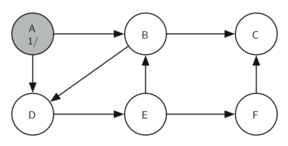
Vertex B is visited next (see below), so its color is set to gray and its discovery time is set to 2. Vertex B is also adjacent to two other nodes (C, D) so we will follow the alphabetical order and visit node C next.
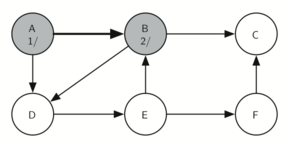
Visiting vertex C (see below) brings us to the end of one branch of the
tree. After adding the node to visited and setting its discovery time
to 3, the algorithm also determines that there are no adjacent vertices
to C.
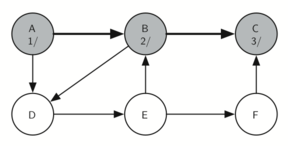
This means that we are done exploring node C and so we can color the vertex black, and set the finish time to 4. You can see the state of our search at this point below.
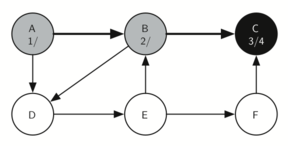
Since vertex C was the end of one branch we now return to vertex B and continue exploring the nodes adjacent to B. The only additional vertex to explore from B is D, so we can now visit D (below) and continue our search from vertex D.
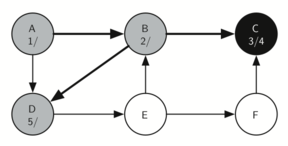
Vertex D quickly leads us to vertex E:
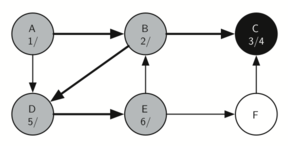
Vertex E has two adjacent vertices, B and F. Normally we would explore these adjacent vertices alphabetically, but since B has already been visited the algorithm recognizes that it should not visit B since doing so would put the algorithm in a loop! So exploration continues with the next vertex in the list, namely F.
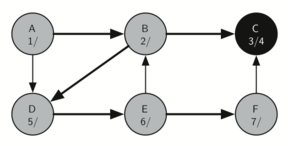
Vertex F has only one adjacent vertex, C, but since C has been visited there is nothing else to explore, and the algorithm has reached the end of another branch. From here on, you will see that the algorithm works its way back to the first node, setting finish times.
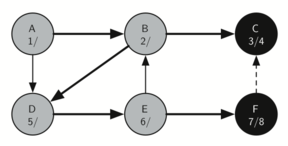
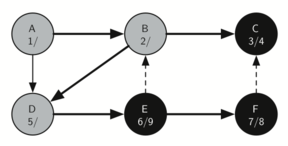
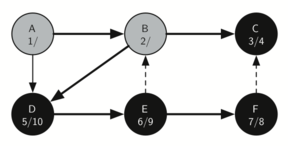
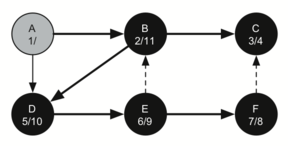
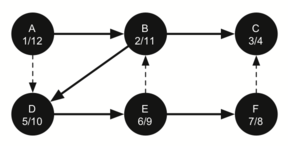
The starting and finishing times for each node display a property called the parenthesis property. This property means that all the children of a particular node in the depth first tree have a later discovery time and an earlier finish time than their parent.